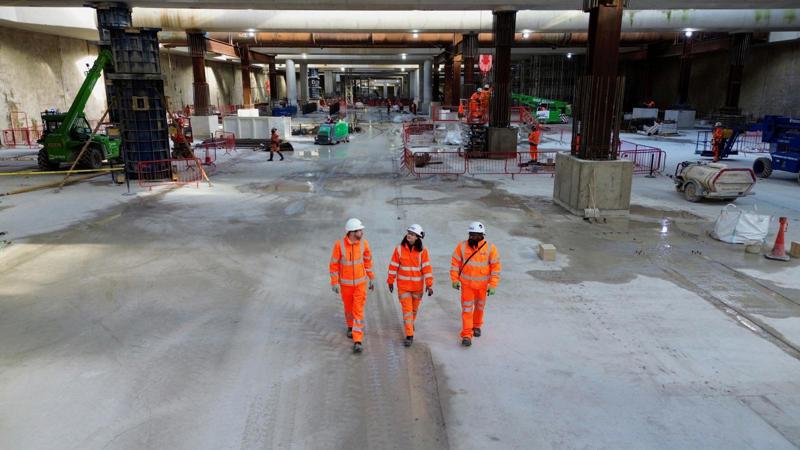
High Speed 2 is a “casebook example of how not to run a major project”, say the members of Parliament who make up the Public Accounts Committee.

High Speed 2 is a “casebook example of how not to run a major project”, say the members of Parliament who make up the Public Accounts Committee.
In their latest report, the MPs continue in similar vein: “It is unacceptable that over a decade into the programme we still do not know what it will cost, what the final scope will be, when it will finally be completed, or what benefits it will deliver.”
That blast is squarely aimed at the government and Department for Transport, rather than HS2 Ltd, which is the company responsible for building the line between London and Birmingham.
That’s because HS2 is a government project. Government decides what it wants built.
Thus, the previous Labour government under Prime Minister Gordon Brown revealed in spring 2010 a network that it wanted to see stretch from London through the West Midlands and on to Manchester and Leeds. This included links on both northern legs to their respective classic main lines to Scotland via West and East Coast routes.
Since then, other prime ministers have cut the plan back.
Boris Johnson axed the eastern leg in 2021 while suggesting that Leeds be served via Manchester’s western leg. Then came Rishi Sunak in 2023, with his axe that lopped the Manchester leg and cut London’s station at Euston from the project.
Sir Keir Starmer has reinstated public funding for tunnels from Old Oak Common in West London through to Euston, but still hopes the station itself will be privately funded.
It should therefore surprise no one that there’s no price tag for HS2, because there’s no agreed scope for the project. And if there’s no agreed scope, there can hardly be an agreed opening date. Or defined benefits.
That doesn’t mean there are not estimates for what the project’s first phase (London-West Midlands) could cost. But HS2 Ltd’s estimates differ from those of the Department for Transport.
HS2 Ltd reckoned costs in a range of £49 billion to £57bn, while the DfT uses £45bn-£54bn. All the figures are in 2019 prices, so need to be uprated by inflation to make them equivalent to cash today. They also date from before Sunak axed Euston from public funding.
The differences come because the two sides disagree over the assumptions behind the estimates. This includes assumptions about what risks remain and by how much better management might increase productivity.
Giving evidence to the committee last December, DfT civil servants said they hoped to have these differences ironed out in “the coming two to three months”.
The way HS2 Ltd treats cost risks with its major contractors remains a vital part of the reset that Mark Wild wants to bring, as HS2’s newly installed chief executive.
HS2 Ltd let its major works contracts as cost-plus deals. This means that taxpayers pay whatever it costs to build the line, plus a bit more on top for the contractors. It leaves the risk of financial overruns with HS2 Ltd and not the contractors. It’s a typical arrangement when building something new and novel for which there are no final designs.
It was a consequence of the way Parliament approved HS2’s construction.
This approval came in broad terms - the Act of Parliament sets out the route, limits of deviation in which construction must take place, and the location of major structures and features.
It left the approval of detailed designs for those structures to local authorities, who could then insist on more expense than might be strictly necessary, knowing that taxpayers would foot the bill.
Wild admitted this when the committee quizzed him last December.
“The rush to start before there was mature design consent was really, in retrospect, a mistake,” he said.
He noted that the National Audit Office had been involved in decisions about the type of contracts to let, and recalled how the NAO had commented that HS2 Ltd had to manage the risks it held.
Wild said: “I don’t mean to criticise people - it must have been very challenging - but the fact is that the transmission of risk from the supply chain to HS2 has resulted in our contracts effectively being cost reimbursable.
“HS2 must, therefore, manage the risk profile. I don’t think that has been done in a coherent way, and we now get an opportunity to fix that.”
Standing as an example of cost risk is the £100 million bat tunnel at Sheephouse Wood, near Calvert in Buckinghamshire. It needed to be 1,000 metres long, and wide enough to span four tracks and to prevent trains from killing bats (which are legally protected) as they fly to and from the adjacent woods.
Committee member Luke Charteris (the MP for York Outer) described £100m for a bat tunnel as “a shocking waste of taxpayer money”.
Wild responded: “I sympathise with the view, and I can understand why, from the outside, this seems an extraordinary amount of money. I have looked at this extensively. I have visited the site myself.
“At the end of the day, HS2 Ltd must comply with the law. The law says we must mitigate - we simply must do that in the law. Then we need to gain planning permission to get it.”
Wild said there had been a four-year delay in gaining this permission from Buckinghamshire Council. Leader of the council is Martin Tett, who has campaigned against HS2 for many years, and permission came only after intervention by the Planning Inspector.
But even with the Inspector’s approval in February 2024, HS2 is now applying to the council for permission to use the precise finishes to the mesh panels incorporated into the tunnel’s design.
The bat tunnel’s cost leads the committee to say that “HS2 Ltd’s efforts to reduce the environmental impact of HS2 are not delivering value for money”, and that the right balance has not been struck between protecting the landscape and wildlife, and the burden that places on taxpayers.
Wild introduced a third area in which he argued that the baseline to which HS2 Ltd is working is out of date.
“The last baseline was 2019. Now, in 2024, if you look at where we are, the activities are all out of synchronism, mostly because of lack of productivity,” he said.
He argued for time to get this right, suggesting that it might take until the middle of 2026 to produce a baseline against which HS2 Ltd’s efforts could be measured.
He drew on his previous experience to add: “I got this wrong at the beginning of Crossrail. We tried to set the baseline within six months, and it proved to be too optimistic.”
With a more realistic baseline and more mature designs, HS2 Ltd might find it possible to reset its programme as Mark Wild hopes, and then renegotiate its four main works contracts.
The committee’s report expresses scepticism, declaring: “We are unconvinced that there are incentives for the contractors to make significant changes and deliver significant cost savings.”
That’s after hearing HS2 Chief Finance Officer Alan Foster say: “We clearly have to reach a compromise there, but there are opportunities for improvement. We do see that as an intrinsic part of the reset.
“Personally, I have spoken to all the CEOs of the parent companies - we have 14 significant entities that sit above the joint ventures - and all expressed willingness to discuss and work through a renegotiation.”
The committee now wants to see reports on HS2 Ltd’s progress in renegotiating contracts included in the six-monthly updates that ministers give Parliament. This first update after the report’s publication should be around June.
It also wants to know by July what HS2 Ltd will do if it cannot renegotiate those deals.
Out on the ground, HS2 Ltd continues to report construction milestones. On February 25, it reported the completion of civil engineering works at Itchington’s one-mile, twin-bore tunnel. It is now ready to be equipped with track, signalling and power.
At Old Oak Common station’s vast sub-surface box, the concrete floor is complete. It’s two metres thick in places and covers the equivalent of six football pitches, says HS2 Ltd.
At the Birmingham end of the line, construction is complete of the first viaduct that will form HS2’s Delta Junction. Early February saw HS2 Ltd complete its longest single-stage viaduct deck slide at Small Dean, near Wendover.
The company reckons that it has over 70% of its 32 miles of tunnels dug, while work is under way on two-thirds of its viaducts and half its bridges. It suggests that more than 31,000 people are at work on HS2 from over 3,300 UK businesses.
HS2 Ltd claims that Britain is already seeing an economic uplift from the project. Around Old Oak Common, it reports a sharp increase in the value of construction projects in the area since Parliament authorised the project in 2017. This comes in the form of more homes and more offices.
As for its opening time, HS2 Ltd and the DfT still talk about a window of 2029 to 2033. If Wild is right in needing to take until the middle of 2026 to put the project on a firm footing for completion, this suggests that a 2029 opening is very optimistic.
The early 2030s seems more likely for the line, which means that Britain will have taken 20 years to build a 140-mile railway.
Login to continue reading
Or register with RAIL to keep up-to-date with the latest news, insight and opinion.


















andreos - 19/03/2025 18:03
Pause it and spend the money on the military.